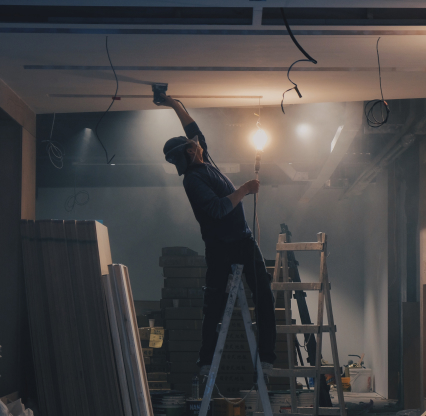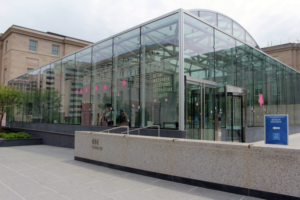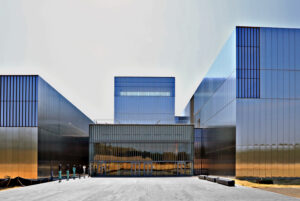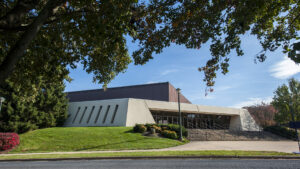Recent Projects
The best way to convey the quality and value of the commercial waterproofing and restoration services we provide is to tell the stories of real-world client projects. Show photos from actual job sites at different phases of the project. Explain what the client needed, the solution we provided, and the results we delivered.
Check out these photos and read case studies that detail recent waterproofing projects. We’ll update this page regularly as projects are completed.

The National Law Enforcement Museum is dedicated to telling the story of American law enforcement and enriching relationships with the communities they serve. This project was unique because the museum is underground and required six sides of waterproofing. For this structure built by Clark Construction, AndieMac had to waterproof the under slab, the walls, and the plaza above, which served as the roof for the museum.

Before the concrete slab was poured, we applied blind-side waterproofing for the under slab and the walls of the structure. We also installed to the sheeting and shoring. On the plaza, we used hot fluid-applied waterproofing.
Blind-side waterproofing is a pre-applied waterproofing because the sheeting and shoring hold back the earth around the perimeter of the structure. Once we waterproofed the sheeting and shoring, the concrete was poured against our waterproofing. When the concrete heated during this process, the adhesive on the surface of the high-density polyethylene (HDPE) backing became activated, providing an integral bond to the poured concrete and monolithically becoming part of the concrete.
For the plaza surface that serves as the roof of the museum, a hot fluid-applied membrane was hot squeegeed onto the surface and fortified with reinforcing fabric and protection board.
The high-end products used for this project – the PREPRUFE line of below-grade waterproofing solutions from GCP Applied Technologies – were specified by the engineer based on the water table and the site location. AndieMac is a certified and approved applicator of GCP products.
Although the water table can introduce complexities at a job site like this, the National Law Enforcement Museum project went very smoothly. As a long-time partner of Clark Construction, we were able to follow their schedule and avoid delays through constant communication and by responding quickly to their needs and questions.
The museum structure is 100 percent watertight. Not only did we use the best products, but our experience and workmanship ensured that the correct procedures were followed. The owners of the museum can feel confident that the priceless items housed in their structure are protected from water damage.
The National Museum of the United States Army opened on November 11, 2020 to honor America’s soldiers, preserve Army history, and educate the public about the Army’s role in America’s history. Part of the museum has five stories above-grade, another part has seven stories above-grade, and there is one story below-grade.
Clark Construction brought Andie Mac into the project after the previous waterproofing company failed to live up to expectations. We were tasked with providing below-grade waterproofing while delivering a level of reliability, responsiveness, and expertise that the previous vendor could not.

We used a GCP Applied Technologies PREPRUFE 300 pre-applied sheet membrane for the horizontal under slab for blind-side waterproofing. A GCP BITUTHENE post-applied sheet membrane was used to waterproof low-grade walls. While pre-applied membranes are done prior to concrete pouring, post-applied membranes are added after concrete is poured and forms are stripped from the walls.
For the above-grade walls, we used a GCP fluid-applied VPL to create an air barrier prior to the facade being built onto the structure. A sheathing board was added by another vendor to the 2x4 metal studs that make up the metal framing. AndieMac then added the air barrier that covers most of the above-grade walls to prevent the buildup of mold and mildew.
Because of the differences in shape in different sections of the museum, we used a JLG Telehandler with a telescoping arm that extended about 60-120 feet to access various parts of the building.
AndieMac was able to overcome the challenges and delays created by the original waterproofing vendor to get the project back on schedule. Then we were able to follow our proven processes, deliver high-quality workmanship, and ensure the safety of everyone on the job site. Having proper waterproofing and air barriers in place will keep the National Museum of the United States Army dry, protected, and strong.
The new James Madison University (JMU) Convocation Center property was built to enhance student and student-athlete experiences while serving as a community showplace for the Shenandoah Valley. Working in partnership with S.B. Ballard Construction, AndieMac was tasked with waterproofing and expansion joint installation for two separate structures – the 8,600-seat basketball arena and the precast parking garage, which is within walking distance behind the arena. Like most modern arenas, the shape of the new JMU Convocation Center is somewhat irregular, unlike traditional, uniformly shaped venues. This required different products and solutions for different parts of the project.

The arena had two levels in the ground, similar to a basement, and required below-grade waterproofing. For these walls, we used a Polyguard post-applied sheet.
A significant amount of caulking was required in vertical and horizontal joints in the parking garage. Because this is a precast structure, multiple parts are pieced together, almost like a Lego set, and then welded along the length of the joints to create one continuous structure.
As a general rule of thumb, when a parking garage extends more than 300 feet, you should install expansion joints, which we did, and caulk those areas to prevent water intrusion. Non-skid traffic coating was applied in several areas of the garage to eliminate water infiltration and provide a non-skid surface.
The arena also required many expansion joints within various structural components. A penetrating concrete sealer was applied in both the parking garage and the arena to prevent water or salt from penetrating the concrete and damaging the reinforcing steel. The precast seating bowl area in the Convocation Center had a number of open vertical and horizontal joints that had to be caulked as well.
As with most waterproofing projects, the key to success is regular communication and responsiveness. This allowed us to keep the project on schedule and maintain a safe work environment. Because AndieMac handled every aspect of waterproofing – above-grade, below-grade, expansion joints, caulking, and traffic coating – we were able to control the quality and process and exceed client expectations.
